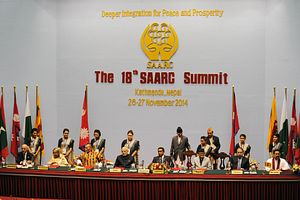The 18th summit of the South Asian Association for Regional Cooperation (SAARC) is underway in Kathmandu, Nepal. SAARC consists of Afghanistan, Bangladesh, Bhutan, India, Maldives, Nepal, Pakistan and Sri Lanka. The prime ministers and presidents of each of those countries gathered in Nepal for the summit, along with diplomatic representatives from SAARC observers – including China.
China has been an observer at SAARC since 2006, but is interested in pursuing full membership. China’s “all weather friend” Pakistan helped push for China’s full inclusion during the SAARC summit but, as has happened in the past, reluctance from India kept the proposal from moving forward. For now, China remains a SAARC observer, a status also claimed by the U.S., Australia, South Korea, Iran, and the European Union.
China’s delegation to the SAARC summit was headed up by Vice Foreign Minister Liu Zhenmin. While in Nepal, Liu pledged that China will seek deeper ties with South Asia, especially on the economic front. “China has put forward a series of initiatives, (including) increasing trade between South Asia and China to 150 billion U.S. dollars and investment to 30 billion U.S. dollars in the next five years,” Liu said. The $30 billion will go to road construction, Liu said.
China’s offer of increased trade and infrastructure development is an off-shoot of the Silk Road Economic Belt, China’s plan for an integrated trading network that will stretch from western China to Central Asia, South Asia, the Middle East, and Europe. Many of the SAARC members (including Afghanistan, Pakistan, the Maldives, Sri Lanka) have already expressed interest in joining either the Silk Road Economic Belt or its oceanic equivalent, the Maritime Silk Road. In addition, Bangladesh, India, Nepal, Pakistan, and Sri Lanka joined China’s Asian Investment Infrastructure Bank, which is expected to act as a major source of funding for Silk Road infrastructure projects.
Though India has signed on to the AIIB, it remains wary of completely buying in to China’s Silk Road vision. During President Xi Jinping’s tour of Central and South Asia in September, India was a notable exception to the general trend of countries enthusiastically announcing their intention to participate in the initiative. Details on the Silk Road projects are still fuzzy, and India is reluctant to commit to joining a project by a rival Asian power.
India is especially wary of increased Chinese influence over its near neighbors. In part as a response to increased Chinese attention to the region, Indian Prime Minister Narendra Modi has made a special point of reaching out to the South Asian nations. This regional outreach includes a new vision for SAARC, a point Modi made clear from the very beginning of his term by inviting all the SAARC leaders to his swearing-in ceremony in May.
Given this, India will look askance at China’s own goals for SAARC, which tie so neatly into China’s larger foreign policy vision for the entire Eurasian continent – a vision that puts China back at the center of the world. On their face, China and India share common goals for SAARC: increasing regional integration, through infrastructure connections and increased economic ties. The issue, of course, is that both India and China ultimately want to be at the center of this regional integration process.
Unfortunately for India, many of the other SAARC members are eager to accept the benefits that come from buying in to China’s projects. With SAARC remaining fractured due to ongoing India-Pakistan tensions, India may have trouble implementing its own strategy of turning SAARC into a unified trading and diplomatic bloc. Meanwhile, China’s own plan works just as well on an individual, bilateral basis, a strategy China has already been successfully pursuing with investment deals in Sri Lanka, the Maldives, and Afghanistan.

































